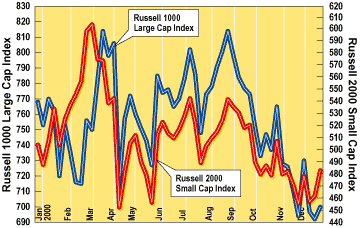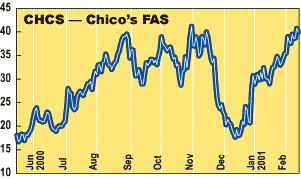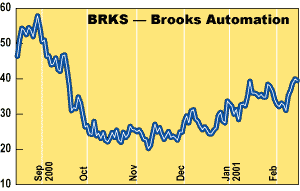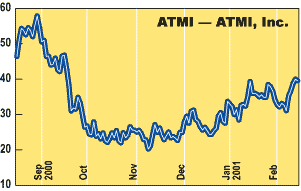
HOT TOPICS LIST
- Strategies
- Stocks
- Buy
- Investing
- Brokers
- Psychology
- Interviews
- Accumulate
- Sell
- Hold
- Spotlight
- Websites
- Candlestick Corner
- Gold & Metals
- Options Trading
LIST OF TOPICS
INVESTING
Small Caps: Growing Value And Valuing Growth
03/26/01 11:35:03 PM PSTby David Penn
With the Nasdaq reeling and the economy teetering on the edge of a recession, why would anyone be interested in small-cap stocks and mutual funds? Growth, for one thing. Value, for another.
| It's something that almost anyone can tell you: Small-cap stocks tend to outperform large-cap stocks on the way up and underperform them on the way down. This conventional wisdom, however, was turned on its head in the final, delirious years of the most recently ended bull market. As Greg McCrickard, manager of T. Rowe Price's Small Cap Stock Fund, put it in a recent update on the fund's strategy: "When the markets [are] really moving up and the animal spirits are in the market and people are feeling great ... people have historically looked to small caps to get that extra bit of performance. It didn't happen this time." What did happen, according to McCrickard and others, was that large-capitalization stocks led the charge to dizzying heights in the spring of 2000 and were among the first, when the overly exuberant valuations of these large-cap companies became suspect, to come crashing down (Figure 1). While the market downturns of 2000 were widespread, the collapse of many large-cap companies may have been an opportunity for small caps. "Given that valuations were very extended for large caps and not so bad for small caps, when we finally had the correction that we saw, small caps actually did pretty well," McCrickard noted.
WHAT ARE SMALL-CAP STOCKS? The textbook definition of a small-cap, or small-capitalization, stock is a stock whose company's total market capitalization -- the market value of all outstanding shares -- is between about $350 million and $750 million. Small-cap companies, as one analyst put it, are the "disregarded, unrecognized backbone of America's economy." Often overlooked due to the lack of brand recognition and major institutional backing (some publicly traded small-cap companies have little, if any, analyst coverage, to boot), small-cap companies are nevertheless the small businesses that provide jobs to hundreds of thousands of Americans and often serve as important product suppliers and service providers for larger companies. Why do small caps tend to outperform large caps? While there is no direct relationship between any given company's market capitalization and its future stock price, there is a strong relationship between a company's market capitalization and that company's ability to raise capital. A company's ability to raise capital to pay for growth and expansion, or to reduce debt, is a major factor in a company's ability to become and remain profitable, and for its stock price to appreciate. Smaller companies tend to have much less capital (in terms of overall assets) to devote to growth and expansion compared to larger companies. Issuing corporate bonds, preferred stock, secondary issues of common stock, bank loans -- all of these are more difficult for smaller companies (say, the RealNetworks of the world) than they are for larger companies (say, the General Electrics of the world). As such, small-cap stocks usually feature higher risk-return ratios than large- or mid-cap stocks. In other words, because the risks are greater, the potential returns must be greater. This form of risk is often referred to as size risk and is among the risk-return questions that investors must ask themselves when they are searching for investment products to help them meet their goals. Size risk can also play a major factor in properly diversifying a portfolio of stocks or mutual funds. A mix of small-cap stocks in a portfolio overweighted with large-cap stocks can help sustain a portfolio's positive returns when larger issues are failing or not advancing as fast as an investor might prefer. WHAT SHOULD INVESTORS IN SMALL-CAP STOCKS LOOK FOR? Analyst Richard Baker has his own mnemonic to help investors remember the key characteristics of small-cap stocks that are likely to appreciate in value. His Miss acronym, which stands for management, innovative and value-added, sector, sales and earnings, helps screen out hundreds of small-cap stocks, making it easier for investors to focus on those small-cap companies that have a background of success and bright growth prospects. "These four things actually precede a big runup in price appreciation in a given stock," Baker adds. With regard to management, he likes business development experience and, especially, subject matter expertise. Businesses started by industry veterans or those with significant academic credentials and accomplishments can often have insurmountable advantages over businesses initiated with little more than entrepreneurial enthusiasm. In the wake of the dot-com meltdown of 2000, Baker also casts a suspicious eye toward what he calls "concept stocks" -- the shares of companies that might be interesting ideas, but turn out to be lousy businesses. "They sound like a great idea," he points out. "But did they really have a market where they were generating existing revenue from customers who were really purchasing products or services?" Another interesting aspect of Baker's methodology is his emphasis on sectors. "When you look at buying a house, you look at the proverbial three most important things: location, location, location," he reminds us. According to Baker, that's the same criteria we should keep in mind in selecting a stock: What sector or area of the economy or what industry will experience growth as a part of demographic changes, changes with technology, or changes of consumer needs? In trying to find small-cap stocks in the early stages of their growth phase, he suggests, looking at sectors can be especially helpful. On this score, some of the small-cap stocks that Baker has been impressed with recently include retailers Chico's Fas (CHCS) and Hot Topic (HOTT). (See Figures 2 and 3.)
Another plus as far as McCrickard is concerned is managements that have a large stake in their companies. "We like them to be on the same side of the table with us," he notes. "If they are not just employees, then they are thinking about building value over long periods." He also thinks that studying sectors can help point the way toward areas of the economy that may be experienc-ing exceptional growth. Says McCrickard, "Really, the sectors of the market tell us where we ought At present, he sees opportunities in the often-treacherous technology sector -- though he tends to be less sanguine on pure semiconductor stocks, for example, referring to them as the "tail end of the whip." Nonetheless, some of the companies he has been impressed by include Brooks Automation (BRKS), a company that makes robotic automation arms as well as software for the semiconductor industry, and ATMI, which manufactures consumables such as air-handling equipment for semiconductor companies. (See Figures 4 and 5.)
Copyright © 2001 Technical Analysis, Inc. All rights reserved. | ||||
Technical Writer for Technical Analysis of STOCKS & COMMODITIES magazine, Working-Money.com, and Traders.com Advantage.
| Title: | Traders.com Technical Writer |
| Company: | Technical Analysis, Inc. |
| Address: | 4757 California Avenue SW |
| Seattle, WA 98116 | |
| Phone # for sales: | 206 938 0570 |
| Fax: | 206 938 1307 |
| Website: | www.traders.com |
| E-mail address: | DPenn@traders.com |
Traders' Resource Links | |
| Charting the Stock Market: The Wyckoff Method -- Books | |
| Working-Money.com -- Online Trading Services | |
| Traders.com Advantage -- Online Trading Services | |
| Technical Analysis of Stocks & Commodities -- Publications and Newsletters | |
| Working Money, at Working-Money.com -- Publications and Newsletters | |
| Traders.com Advantage -- Publications and Newsletters | |
| Professional Traders Starter Kit -- Software | |
PRINT THIS ARTICLE

|

Request Information From Our Sponsors
- StockCharts.com, Inc.
- Candle Patterns
- Candlestick Charting Explained
- Intermarket Technical Analysis
- John Murphy on Chart Analysis
- John Murphy's Chart Pattern Recognition
- John Murphy's Market Message
- MurphyExplainsMarketAnalysis-Intermarket Analysis
- MurphyExplainsMarketAnalysis-Visual Analysis
- StockCharts.com
- Technical Analysis of the Financial Markets
- The Visual Investor
- VectorVest, Inc.
- Executive Premier Workshop
- One-Day Options Course
- OptionsPro
- Retirement Income Workshop
- Sure-Fire Trading Systems (VectorVest, Inc.)
- Trading as a Business Workshop
- VectorVest 7 EOD
- VectorVest 7 RealTime/IntraDay
- VectorVest AutoTester
- VectorVest Educational Services
- VectorVest OnLine
- VectorVest Options Analyzer
- VectorVest ProGraphics v6.0
- VectorVest ProTrader 7
- VectorVest RealTime Derby Tool
- VectorVest Simulator
- VectorVest Variator
- VectorVest Watchdog





